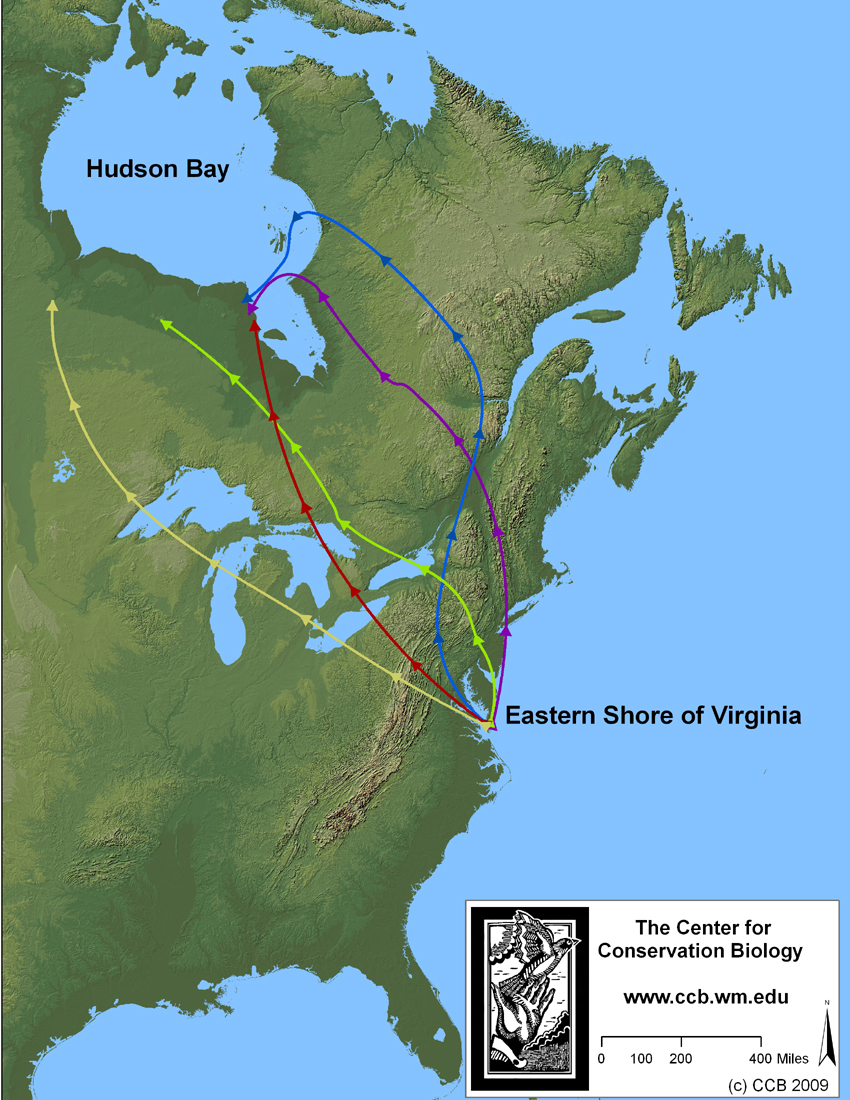CCB tracks whimbrels to Hudson Bay
 The tracking project is part of an ongoing research effort to discover migratory routes that connect breeding and winter areas and to identify en route staging areas that are critical to the conservation of this declining species. The five birds took four-to-sevendays to fly between 1,940 and 2,800 km (1,200 and 1,740 miles). Three of the five birds made short stops on the eastern Great Lakes before moving on to breeding areas along the western shoreline of James Bay and the interior lowlands west of Hudson Bay. Two of the birds appear to have been blown east by a strong cold front but made correction flights to the breeding grounds. The birds confirmed the anticipated connection between the lower Delmarva staging area and the eastern breeding population.
The tracking project is part of an ongoing research effort to discover migratory routes that connect breeding and winter areas and to identify en route staging areas that are critical to the conservation of this declining species. The five birds took four-to-sevendays to fly between 1,940 and 2,800 km (1,200 and 1,740 miles). Three of the five birds made short stops on the eastern Great Lakes before moving on to breeding areas along the western shoreline of James Bay and the interior lowlands west of Hudson Bay. Two of the birds appear to have been blown east by a strong cold front but made correction flights to the breeding grounds. The birds confirmed the anticipated connection between the lower Delmarva staging area and the eastern breeding population. Updated tracking maps may be monitored online.
Background
The whimbrel is a large, holarctic, highly migratory shorebird. The North American race includes two disjunct breeding populations both of which winter primarily in Central and South America. The western population breeds in Alaska and the Northwest Territories of Canada. The eastern population breeds south and west of Hudson Bay in Manitoba and Ontario. Both populations are of high conservation concern due to dramatic declines in recent decades.
The seaside of the lower Delmarva Peninsula in Virginia is a critical, migratory staging area where whimbrels gorge on fiddler crabs and marine worms in preparation for an overland flight to the breeding grounds. In the spring of 2008, a whimbrel (named Winnie) was tracked from this site on a 5,000 kilometer, transcontinental flight to the MacKenzie River near Alaska. The five birds tracked in 2009, though flying shorter distances, confirm the long-expected link between conditions within the lower Delmarva staging area and the Hudson Bay breeding population. The route followed by these birds provides further evidence that the Delmarva represents a terminal coastal staging area during spring migration. A bird tracked in the fall of 2008 left the lower Delmarva and made a transoceanic flight south to winter in coastal Guyana suggesting that the site may also represent a terminal staging area during fall migration.
Satellite tracking represents only one aspect of a broader, integrated investigation of whimbrel migration. During the past 2 years, the Center for Conservation in partnership with The Nature Conservancy and the U.S. Fish and Wildlife Service has used conventional transmitters to examine stopover duration, conducted aerial surveys to estimate seasonal numbers, collected feather samples to locate summer and winter areas through stable-isotope analysis, and has initiated a whimbrel watch program. Continued research is planned to further link populations across staging, breeding, and wintering areas and to determine the ecological requirements of whimbrels staging along the peninsula.















